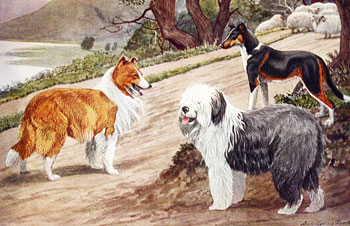Dog Breeds
Dog Tips
Training
Exercise
Medical
Interviews
Miscellaneous
About DB
Contact DB
Resources

Illustration by Louis Agassiz Fuertes
Collie
There is little resemblance between the working “collie” of the Scottish sheep-herder and the elaborately furred, slender faced, beuchdog now so popular. The broad-skulled, rather neglected looking “shepherd dog” of our boyhood, with his friendly, democratic manners (or lack of them) would get short shrift now at any show or gathering of the elite, while of all dogs his handsome, richly frilled descendant with all the ear-marks of aristocracy, is the cause of more “Ohs” and “Ahs” than any other dog in the show.
Nevertheless, one might see an “ornery-looking,” half-moulted type of the countryside handle a drove of 3,000 or more sheep in Saskatchewan in a manner to bring one up standing. And when, on returning at nightfall, he puts every ewe and lamb in one corral and every ram in another, without error or violence, one feels like asking him if he would shake hands with a mere spectator! It is doubtful if any borzoi-headed champion could do that with a lifetime of training.
Still, the collie is a most intelligent and handsome dog, and the present tendancy is toward a greatly elongated and consequently narrowed head, forming almost a straight or even slightly deflected line from nose to occiput. The neck, throat, and chest bear a great frill of long hair, and the back of the thighs also is very deeply and richly furred. The hair of the body is long and straight, rather harsh, but with a deep and woolly undercoat. The feet, from hock and wrist down, should be smooth.
In color, the collie may be black and tan, “sable,” or rich orange brown, with white frill, callar, and face “harlequin;” or white, with black spotting and freckling at random; “blue,” or mouse color, and white, or even pure white everywhere. Some few kennels specialize in white collies and advertise extensively; they are very beautiful dogs, though probably requiring more care to keep presentable than the more “practical” colors, as our mothers would call them.
The collie should stand 20 to 24 inches and weigh from 40 to 60 pounds. He requires considerable exercise, and while growing up needs watching to prevent his acquiring a taste for chickens and even lamb. Once this predilection gets established, it is hard if not impossible to eradicate.
In this country we know the collie chiefly as a beautiful, vivacious, and alert companion, but in the great sheep-raising districts of Scotland, northern England, and Wales, he is an absolutely indispensable assistant of the shepherd.
Not that the working collie looks very much like the long-muzzled, much-beruffled, and well groomed specimens which grace the benches at our dog shows. He would never be allowed inside the ring at Madison Square Garden, and if he were he would stand about as much chance of taking a prize as a blue-ribbon winner would have of defeating him in one of the great annual sheep-dog trials of his native land. He lacks the superficial beauty necessary to win in the show-ring but he has the brains, the courage, and the stamina without which the sheep industry of Great Britain would quickly come to a standstill.
In the land of misty mountains one good dog can do the work of a dozen men, and there is no other animal which could possibly replace him.
Obeying the voice, or better still, the whistle, of his master, a good working collie will “run out” to a distant pasture, round up his flock, separating them if necessary from other sheep, and bring them along at just the right speed; head off any which may try to take a wrong direction; go back and hurry those which lag behind; fight off strange dogs if necessary, and finally bring them into the fold without losing one.
Next morning he will take them away to the pasture and guard them all day, if asked to do so, or help his master to drive them to the market, along the quiet country lanes and the crowded city streets alike, preventing every attempt of his charges to wander or stampede.
The Shetland collie, a tiny sheep-herder weighing between six and ten pounds and imported from the Shetland Islands, is becoming known in the country as an attractive pet.
Smooth Collie
The smooth collie is to be judged by exactly the same standards in everything, except coat, as the rough, or common, collie.
The artist had never seen one and was somewhat desperate for a model, when to his surprise he found that the Belgian farmer who comes for the neighborhood garbage was accompanied by a fine specimen, brought with him in 1914 from home, whence he fled at the instance of the Hun!
It is somewhat of a surprise to see what a collie looks like in short hair, but it rather increases our regard for him than otherwise. For he is a fine, strong, “doggy” animal, and in this example, at least, the “refinement” which so often results in extremely nervous and high-strung dogs has not been sought.
The present fad for long, slender, roman-nosed and narrow-faced collies seems to introduce an entirely undesirable slenderness of temper as well, quite different from the genial, easy-going dependability of the “old-fashioned” collie, wide between the eyes and ears. It is a distinct loss to the breed.
Did you enjoy this article? Let us know what you think by commenting below. Don't forget to Friend us on facebook and subscribe to our twitter feed to stay updated! Thanks for reading, recommend us to your friends! |
